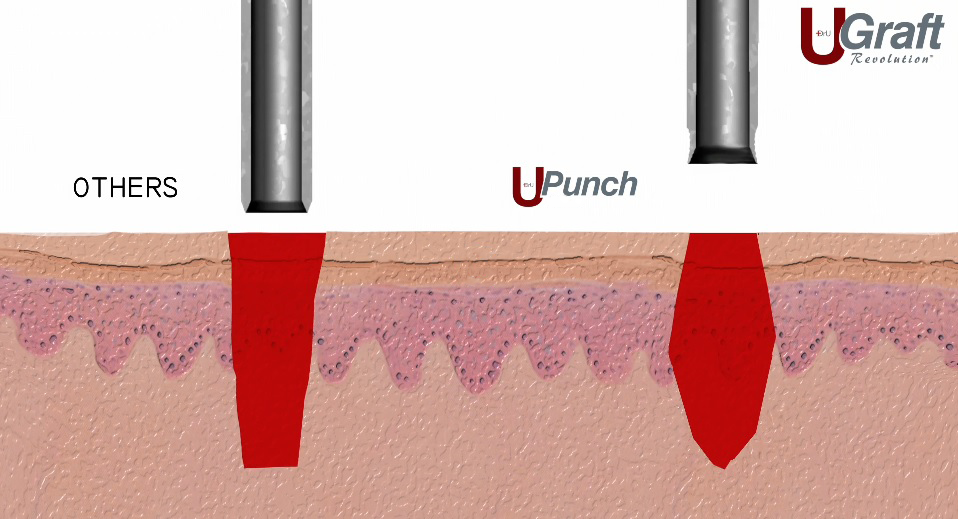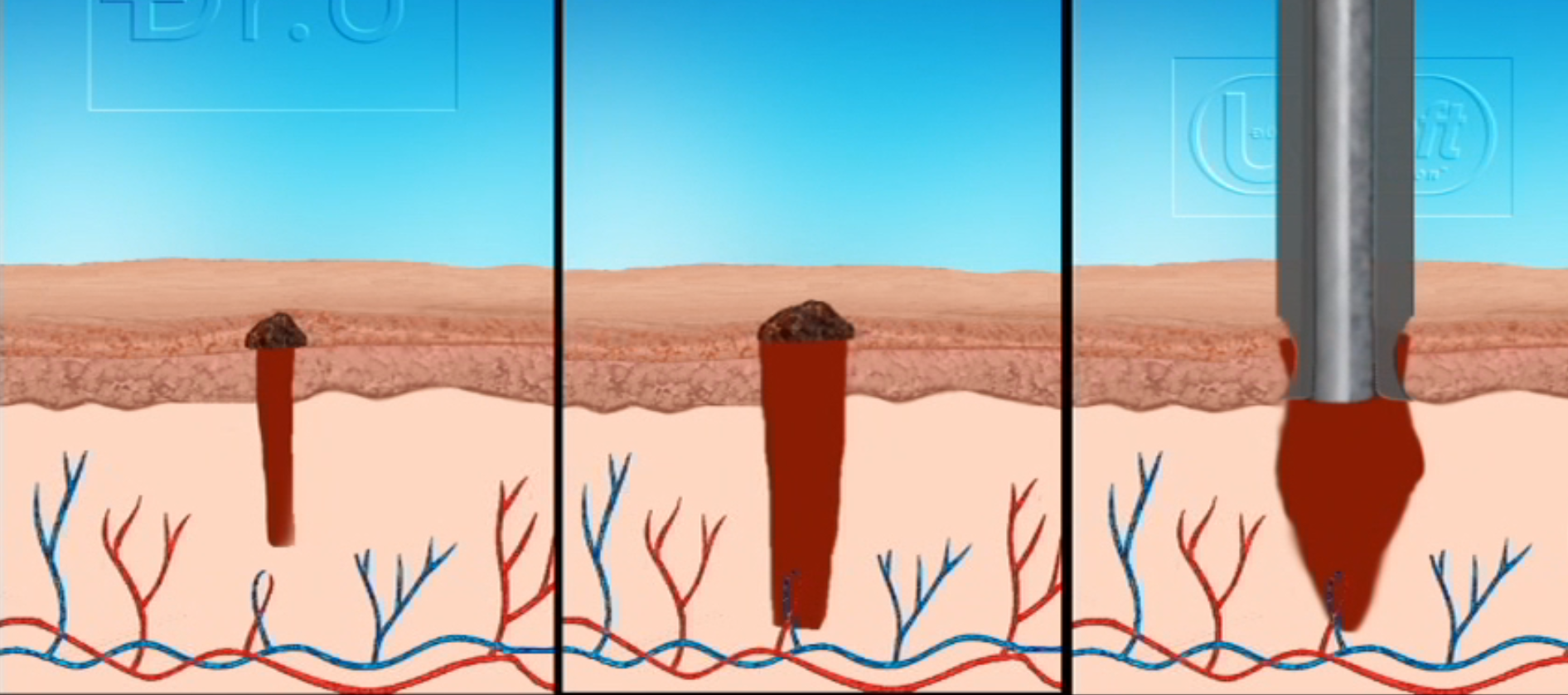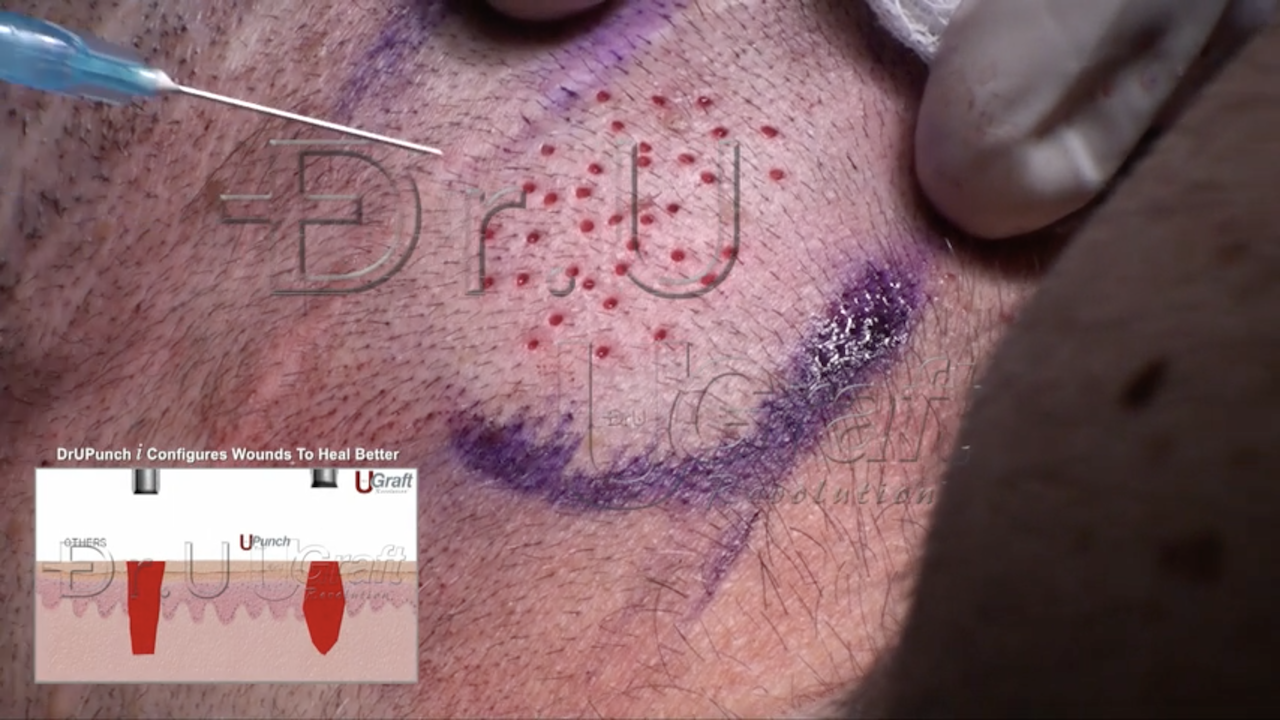One of the main objectives of minimally invasive follicular unit extraction hair transplant procedures is to minimize wound healing footprints. In order to make higher wound healing standards possible, it becomes necessary to identify the obstacles in the way of this goal. Hence, one of the primary intents behind the design of the Dr.UGraft ™ flared punches was to enable better linear scar free hair transplant donor wound healing. This was achieved by enhancing the shape of the wounds created in the dermis to render the most cosmetically insignificant scarring, thus allowing the skin to heal with lesser signs of scarring.
Why Is There A Need For Better FUE Hair Transplant Donor Wound Healing?

Dr.UGraft enables better linear scar free hair transplant donor wound healing due to the shape of the wound cavity it creates
Many challenging hair transplant patient needs, in terms of quality and quantity, can be met by extracting non-traditional donor hair grafts. These non-traditional grafts come from beyond the regions of the conventional areas of the scalp. This includes nape hair, as well as hair from various other regions of the body. An important consideration, however, is the need for better linear scar free hair transplant donor wound healing, particularly since these areas are more open and exposed, since these surfaces have less hair density.
Nape Hair – Better Linear Scar Free Hair Transplant Donor Wound Healing
Nape hair is much thinner than regular head hair. Because of this quality, it is an ideal choice for recreating the soft, feathery outer edge of the hairline. Additionally, this graft choice can be used for eyelash and brow transplants due its matching caliber. The nape area is more exposed in patients who keep their hair closely shaved in this area.
Beard Hair – Better Linear Scar Free Hair Transplant Donor Wound Healing
Beard hair is also present in more open areas since it grows on the face and neck. Better linear scar free hair transplant donor wound healing results are, therefore, an absolute necessity, especially since this region is often relied upon to supply large quantities of grafts.
Additional donor areas on the body which also require better linear scar free hair transplant donor wound healing standards include the chest, abdomen, back, arms and legs.
Ideally, the skin should be left without any noticeable and visible signs of redness or raised scarring. Patients would be able to benefit from the quality and/or quantity of grafts supplied in these areas without being left with obvious markings of surgery.
This can be achieved by making improvements in the shape of wound cavity configurations.
Minimally Invasive Hair Transplant Surgery Wound Configurations and Hair Transplant Healing Phase
Many patients choose Follicular Unit Extraction over strip surgery because an FUE hair transplant will not leave any linear scars. Therefore, they can choose to wear their hair extremely short without anyone being able to tell that they had undergone surgery. From the top view, conventional FUE wounds look like tiny round dots that often appear as white or red, depending on the nature of the patient’s skin.
The basic shape of traditional Follicular Unit Extraction punches is cylindrical with an inward pointing bevel at the tip end. Upon rotation, the vector of the cutting edge points towards the center.
When looking at a cross-sectional view of the wound cavity created from such punches, the shape can be described as everted, resembling an upside-down pyramid without the apex.
During the skin healing process, the sides of the wound close. However, with everted wound shapes, the extraneous tissue around the surface opening aggregates into a raised mound of scar tissue.
In order to achieve better FUE donor wound healing, the degree of wound eversion (The width of the upside down pyramid) must be minimized.
How Dr.UGraft Revises Wound Cavity Shapes For Better Linear Scar Free Hair Transplant Donor Wound Healing
Dr.UGraft’s distinctive flaring of its rotary devices expands the cutting diameter beyond the circumference of their actual punch diameter. This forms a relative widening in the middle of the wound cavity. This new shape promotes a brand new wound healing dynamic.

It is possible to achieve better linear scar free hair transplant donor wound healing with the rotary Dr.UGraft punch. It’s flared feature creates a distinct wound cavity shape. When the skin heals, this leaves no visible signs of scarring or redness. This sets it apart from wounds created with non-flared punches.
This inherent intelligence of Dr.UGraft’s engineering leads to better FUE hair transplant donor wound healing outcomes. The formation of scars is an inevitable part of the skin healing process. However, due to the wound configurations created by Dr.UGraft’s rotary punches, any scarring that develops is typically cosmetically insignificant. Additionally, the flaring serves to provide a protective safety measure against graft transection. Additionally, the flaring gathers more tissue around the grafts to lead to bulkier grafts which have a better survival profile compared to slimmer grafts.
With improved wound healing outcomes provided by Dr.UGraft, the use of non-conventional grafts from areas like the nape, beard, chest, abdomen, back, arms and legs can feasibly help patients achieve the coverage they want, or more natural looking details in areas like the hairline, eyebrows, and eyelashes. Also, their skin is able to heal beautifully, allowing them to move past their surgery with a renewed appearance on their head, eyebrows or eyelashes.
Video: Dr.UGraft’s Intelligent Punch Extracts Nape Hair
Watch Dr. Umar demonstrate the use of his Dr.UPunch i ™ to harvest donor hair from the nape area.
Different Skin Types and Wound Healing Results of Dr.UGraft
After a Dr.UGraft hair transplant, various wound healing patterns can develop depending on a patient’s skin type. The Fitzpatrick scale defines six categories, according to skin tone based on melanin content and how the skin reacts to prolonged sun exposure.
- Type 1 – skin tone is very fair and light, often times with the individual having red or blond hair; skin won’t be able to tan but will burn or freckle when exposed excessively to the sun.
- Type 2 – skin tone is fair, often paired with red or blond hair; skin is capable of minimal degrees of tanning but more likely to experience sunburns instead.
- Type 3 – skin tone is light, leaning towards cream shades with subtle yellow undertones; tanning can be achieved uniformly and sun burning is minimal.
- Type 4 – skin tone is medium in shade with possible Mediterranean olive undertones; skin tans very easily but rarely burns
- Type 5 – skin tone is dark brown, comparable to average Middle Eastern demographics; tanning is readily achieved, but skin burns are rare
- Type 6 – skin tone is dark brown/black; there is an easy tendency for tanning to occur, but the skin does not burn.
These skin types can display unique wound healing characteristics and patterns, following a Dr.UGraft surgery.
Click the button below to learn how to become a Dr.UGraft provider.
Frequently Asked Questions – Better Linear Scar Free Hair Transplant Donor Wound Healing
How long do FUE hair surgery donor wounds take to heal?
The donor area typically heals within 10 to 14 days after a hair restoration procedure, creating linear scar free donor wounds.
If I am interested in better FUE hair transplant donor wound healing, is it possible for me to choose a different donor area?
You may want to speak to your doctor about your concerns. He or she may be willing to conduct a test extraction on a small discrete area so that you can see how your skin heals in a particular region. But aside from this, it is certainly possible for you to choose a particular donor area which can meet your goals for graft quantity and quality as well.

